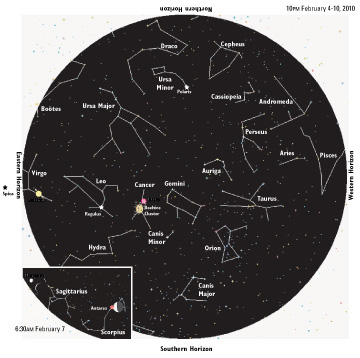Chesapeake Bay's Independent Newspaper ~ Since 1993
1629 Forest Drive, Annapolis, MD 21403 ~ 410-626-9888
Volume xviii, Issue 5 ~ February 4 - February 10, 2010
Home \\ Correspondence \\ from the Editor \\ Submit a Letter \\ Classifieds \\ Contact Us
Best of the Bay \\ Dining Guide \\ Home & Garden Guide \\ Archives \\ Distribution \\ Advertising![]()


Sky Watch

by J. Alex Knoll
Lighting these Cold Nights
Fiery planets and buzzing stars warm our winter sky
The waning moon travels through pre-dawn skies, reaching last-quarter Friday the 5th. Early morning of the 7th, look for the crescent moon a few degrees west of the red-giant Antares, the heart of Scorpius, the scorpion. Thursday morning, just before daybreak, look for the last sliver of moon low in the southeast with Mercury only a couple degrees to the east.
As the sun sets a little after 5:30, Jupiter appears low in the southwest before dipping beneath the horizon less than 90 minutes later.
Fiery Mars now commands our skies, rising in the northeast with sunset, reaching its zenith high in the south at midnight and setting in the northwest with daybreak. Already one of the brighter objects in the sky, the red planet blazes amid the faint stars of Cancer, the crab.
None of Cancer’s stars are standouts, and you’ll be hard-pressed to distinguish its crustacean shape. But the heart of the crab is abuzz with the stars of the Beehive Cluster. And this week, Mars shines just three degrees to the north of the cluster — well within the field of view of a pair of binoculars. Away from city lights, the Beehive Cluster appears as a fuzzy patch of light. But with binoculars, the many bees of this hive pop into view.
As Mars sets in the pre-dawn glow, Mercury rises in the east-southeast. While brighter than Mars, Mercury never strays far from the sun, keeping tight to the horizon in its brief appearances. In the hour before dawn, scan the east-southeast horizon — preferably with binoculars. Don’t be misled by the dimmer lights of Antares higher to the right or Altair higher to the left.
With Venus buried in the glare of the sun, Saturn is the only other naked-eye planet visible. Were it not for its steady golden glow, you might mistake Saturn for a star positioned mid-way between equally bright Regulus to the west or Spica to the east.
Illustration: © Copyright 1925 M.C. Escher/Cordon Art-Baarn-Holland; Graphics: © Copyright 2010 Pacific Publishers. Reprinted by permission from the Tidelog graphic almanac. Bound copies of the annual Tidelog for Chesapeake Bay are $14.95 ppd. from Pacific Publishers, Box 480, Bolinas, CA 94924. Phone 415-868-2909. Weather affects tides. This information is believed to be reliable but no guarantee of accuracy is made by Bay Weekly or Pacific Publishers. The actual layout of Tidelog differs from that used in Bay Weekly. Tidelog graphics are repositioned to reflect Bay Weekly’s distribution cycle.Tides are based on National Oceanic and Atmospheric Administration and are positioned to coincide with high and low tides of Tidelog.
© COPYRIGHT 2010 by New Bay Enterprises, Inc. All rights reserved.
